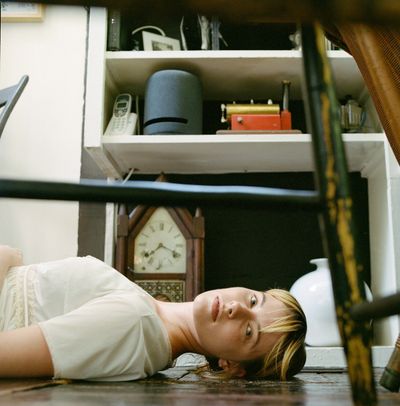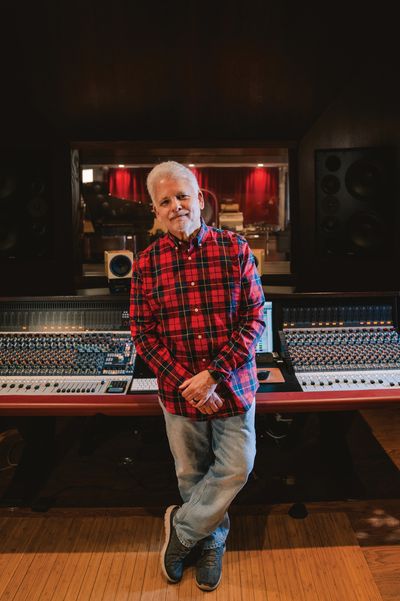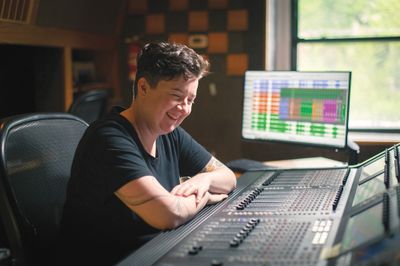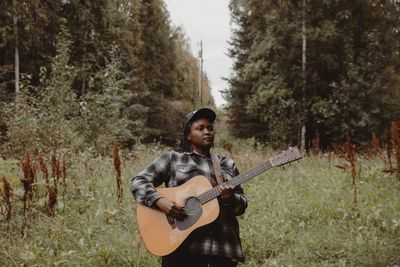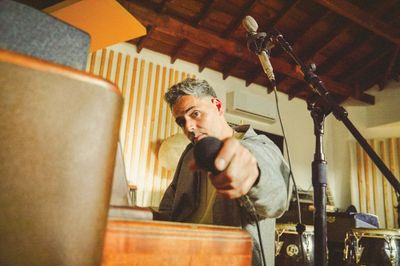Having started as an artist and multi-instrumentalist, what led you to engineering and production?
One of the first jobs I had was working in a music store in Minneapolis, selling guitars and synths. I made some contacts there and I started engineering for the Fairlight Series III. The orchestral libraries we produced required me to hyper-focus on the recording and engineering aspects, which helped to discipline and develop my ears in a new way. I was then asked by some friends to design their recording studio, which was based around a Synclavier. I stayed on at that studio and ran the Synclavier for a few years, until I moved from Minneapolis to L.A. to work for Virgin Records as a house engineer/producer. I still love the Synclav — great sounds! After three years as Director of Audio for Virgin in L.A., I was ready to work on a wider variety of projects, incorporating music and sounds that aren't necessarily music in the usual sense. I started Sound Furnace, Inc. to do just that.
A lot of your more recent work seems to be in the form of avant-garde sound installations and museum pieces. What sparked your move into this arena?
It all started in college, really. I used a Simmons EPROM blower to make a mannequin respond by striking it with a drumstick. I think it said, "Please have a mint." Several years ago I was approached by my friend, well-known artist Doug Aitken, to create the sound for his three-screen epic installation entitled "Interiors" — which has just been added to the MOMA's permanent collection. It's a piece about chaos and harmony, and about how rhythms and musical time can come together and then separate, like the collision of sound from a passing car interacting with your own voice to create something new and larger — and, in some cases, quite interesting.
Describe this a bit more. I'm trying to imagine what kinds of sounds you are talking about.
This particular piece is comprised of four scenes cycling over three separate screens. Each scene follows individual actors (one of whom is Andre 3000 from the hip-hop duo Outkast) through different landscapes and spaces. I started with real sounds to match each scene, and slowly began to process and warp the sounds, to soften the edges and create something more tailored. The music was created by matching the tempos for each scene, and then sequencing the more organic parts of the instrumentation to fit with the sound. As time passes while the observer is watching the piece, the actors' worlds begin to intersect and sync up with each other, culminating in an intense piece of music composed of a tap dancer, an auctioneer, a handball player and a rapper. Three separate stereo music and sound mixes slowly fall in time with one another at certain key moments. It's like a wave breaking. The sound starts very simple, and then slowly develops into a wild crescendo — only to go silent and begin again. It's very hypnotic. It took me about two months to finish this particular piece.
It must be an interesting experience creating a sound installation for a museum space, as opposed to the typical hip-hop, indie rock or singer- songwriter music that most engineers and producers are involved with these days.
It is, because that environment is such a totally different way of experiencing sound and visuals. It's almost like being in a church or a cathedral. You're going to a specific place to experience something with no real expectations other than that you will be part of that environment for a certain amount of time. There is film or video, but you don't have a trailer showing you what you are going to see next on the screen. Usually the spaces are very large , so managing that can b e challenging. Carpet and other sound- absorbing materials are generally used. This tends to create more intimate and pleasant spaces. With this piece that we've been discussing — and I didn't plan this, it just ended up being a sort of happy accident — the observer hears the sound as he or she is walking towards the gallery, and then once inside, when they see the picture and the actual scope of what is being presented to them it's quite surprising. You can hear the subwoofers kicking out the low-end frequencies from farther away, and as you get closer to the room, more frequencies come into focus. The way the spectrum of the sound changes and becomes fuller, more vibrant, as you approach the piece and then thinner, less powerful as you depart, has a lot to do with the impact of the work — particularly when it all combines with the video portion to create that "something greater" that we talked about a moment ago.
What are you working on currently?
Installation-wise, I'm working on a sound pavilion in Brazil. At the center of the pavilion is a small hole that reaches deep into the earth. At various points in the hole, very sensitive microphones pick up signals that are in turn fed to a number of speakers back at the surface. The sound heard inside the pavilion is quite literally an amplified live feed of the earth's interior at that location.The sound frequencies picked up by these microphones will automate certain parameters, faders or events, creating an endless stream of sound that will be hypnotic, and at times even aggressive. The earth will "play itself," so to speak. I'm also creating a music engine for a restaurant in Venice. "Sound and Architecture," a redefined and determined environment created live each moment by its occupants. The patrons will inadvertently drive triggers and transducers to create the music and sound that they are then experiencing. These sounds and music are generated based on whether or not an input audio signal is detected. In addition, the system will measure ambient noise levels and automatically and dynamically adjust the program level for optimum balance and intelligibility. It is totally automated and will never produce the same music twice. The sound and music will rise or increase in intensity with the number of people occupying the space. I just finished creating the sound to accompany Doug's monumental MOMA piece, "Sleepwalkers." I'm also restoring a number of experimental music devices from the late '60s and early '70s — like a biofeedback music machine that creates music from alpha, beta and theta brainwaves. The device can accommodate four separate people (or brains) at one time. A brainwave chamber ensemble! It's totally sick! It's alive!
Let's switch gears for a moment. Tell me about your record label, Sound Furnace.
I keep hearing about the music infrastructure collapsing. I think it's actually expanding — or evolving. Creating a label is a response to that situation. It's a way for me to release music I'm involved in and enjoy — and to have more of a say in how it's presented. As a blueprint, I like to think of 4AD Records and what Ivo Watts-Russell was trying to do. All of the bands on that label complimented each other, but were different. The Pixies, Cocteau Twins, Colourbox, Clan of Xymox, Dead Can Dance — they were all definitely amazing! I'm going to keep it small. I want to help bands I like. I still produce and engineer quite a bit. I'm working with three different bands at the moment. I like to keep it interesting, so they really are quite varied. Jonathan Bell is sort of a cross between Steely Dan, Burt Bacharach, and Brahms — maybe with a little Joe Jackson thrown in. His arrangements are fairly complex, but without going too far. Lincoln Madley is another artist who is also slamming a few styles together. His sound is like taking Daft Punk and adding an acoustic, or even folk element. I work with a guy named Ray, which is short for something I can't even pronounce. He's from Iran and is in his fifties, with the most amazing singing voice. Very traditional Iranian vocals along with more contemporary instrumentation. So it's an interesting mixture, the different band projects that I am currently working on. I've also started to write the follow up to a record I did last year with my wife called Love Goes. We have a group together called The D&A. I should be finished with the new record by summer. We're at a weird time with the music industry right now. Sonically, it's headed in a different direction than ever before. This is the first time that you can record with the highest quality audio that's ever been invented, and then have your music delivered to an audience in an ultra-compressed (mp3) format with absolute shit quality. I'd like to receive my music over the Internet at full bandwidth, thank you very much. I think the most important thing is to create good music — good sounds. Something that causes an emotion. Something that makes the chemicals in your body change in a certain, real way. It's about pain, sorrow, happiness — the whole gamut of emotions. You can experience every emotion you've ever felt through music. And good sound can relate to things other than music. Like the way that the air conditioner's rhythm is interacting with the way that guy's silverware is tapping over there, and both of those sounds are combining with the way that our waitress is speaking — all while we are conducting this interview. That's good sound. I like it when I'm in my car at an intersection and interference from someone else's car radio blends with what I'm listening to in my car to create a moment of something bizarre and interesting. Something unintended and perfect. And new.
